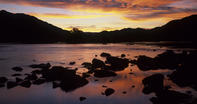Fertile Places
The Orange River is the only perennial water source in the Richtersveld, and it supports a fairly traditional assortment of fresh-water species. Fish include yellow fish, sharptooth catfish (barbel), sardine, banded bream and the endemic Namaqua barb.

The Cape clawless otter can be seen around the mouth of the river, at Alexander Bay, and large numbers of Cape fur seals (now called the South African fur seal) can be found along the coast. The wide Orange River mouth (or estuary) is one of the most fertile places in the region. With its mud flats, marshes, flood plains and islands, it supports an amazing diversity of birds – up to 10 000 of them, representing over 60 species.
These include flamingos (many hundreds of which can be seen perching precariously in the water), Cape cormorants, chestnut-banded plovers, Egyptian geese, Cape teal, Great white pelican, South African shelduck and the African sacred ibis. There are also about 14 species that are listed in the IUCN Red List of Threatened Species.
These include the Damara tern, African purple swamphen, Barlow’s lark and the Cape long-billed lark. In light of this, the Orange River mouth has been declared a RAMSAR wetland of international importance.
Unfortunately, the site has been severely degraded by all the mining activity that takes place along both banks; its plight being barely noticed by environmental watchdogs because of its location within the formerly restricted diamond mining town of Alexander Bay. Now, thankfully, the various Namibian and South African authorities are trying to rehabilitate this wetland and restore it to its former glory.
By David Fleminger